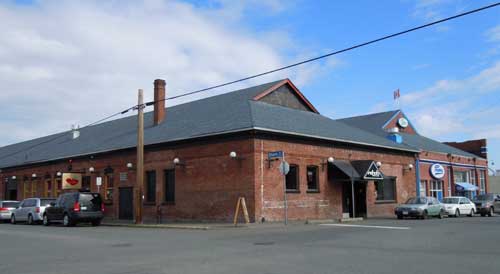Heritage Register
Burnside
502 Discovery Street
Built:
1901; 1907
Heritage-Designated 2018
For: BC Electric Railway Company (BCER)
Architect: Francis Mawson Rattenbury
Contractor: John Coughlan

ARCHITECTURE:
Both these large brick streetcar barns have gables on the original front end on Pembroke, and gable-on-hip roofs on the rear, now the primary address on Discovery. The Discovery St façades have central entrances and two segmentally-arched windows, but larger single pane windows with concrete headers and less elaborate brickwork have been substituted. The Store St façade retains many segmentally-arched windows with brick keystones and four entrance doors. Some multi-pane sashes survive.The Pembroke St gables each have large semi-circular, multi-paned windows and brick keystones. The Pembroke St façade has concrete piers and lintels now incorporated into brickwork with large service doors; the barn doors for entry of the streetcars originally hung here. The long east wall, opposite Store St, has no openings.
A very important part of Victoria’s early industrial history survives in the former BCER depot. It was built on Pembroke at a cost of $15,000. An extension to Discovery St in 1907, also designed by Rattenbury, provided pits, storage tracks and a paint shop, for $9,500.
ORIGINAL OCCUPANTS:
In November 1888 the city of Victoria authorized a group of citizens to construct a street railway for the city and to supply electricity for lighting. They included James Douglas Warren, Thomas Shotbolt, David W. Higgins (1501 Fort St, Rockland), Andrew Gray (1135 Catherine St, Vic West) and Joseph Hunter (514 Government St, James Bay). The National Electrical Tramways & Lighting Co was incorporated in 1889 with capital of $250,000. Streetcar services began in 1890 with six miles of track and five cars, the first streetcar system on the North Pacific coast and one of the first in Canada. Streetcar rides initially cost 5¢, then 7¢. Drivers and conductors worked 10-hour days for 22¢ an hour. In 1894 the name was changed to Victoria Electric Railway & Lighting Co.
The company was almost accident free until May 26, 1896 when the Point Ellice Bridge collapsed under an over-loaded streetcar. The conductor and 58 passengers died. A series of legal claims against the city followed, because of a decayed beam in the bridge’s centre span. The company became Consolidated Railway Co, which was taken over by the BC Electric Railway Co. BCER continued until 1951 when “railway” was dropped, since streetcar service had gone. In 1960-61 it became BC Hydro and Power Authority.
Victoria’s former streetcar barns are the only complete ones still in existence in BC.
OTHER OCCUPANTS:
BC Hydro used the buildings up to the 1980s, after which a variety of retail, warehousing and entertainment businesses moved in. The buildings are presently tenanted by the Duke Saloon, Sports Traders, and Victoria Gymnastics.
ADDITIONAL INFORMATION & IMAGES:
• Statement of Significance (Canadian Register of Historic Places)
• Map of Victoria Heritage Register Properties
• Burnside History
• Burnside Heritage Register
• This Old House, Victoria's Heritage Neighbourhoods,
Volume Three: Rockland, Burnside, Harris Green,
Hillside-Quadra,
North Park & Oaklands

